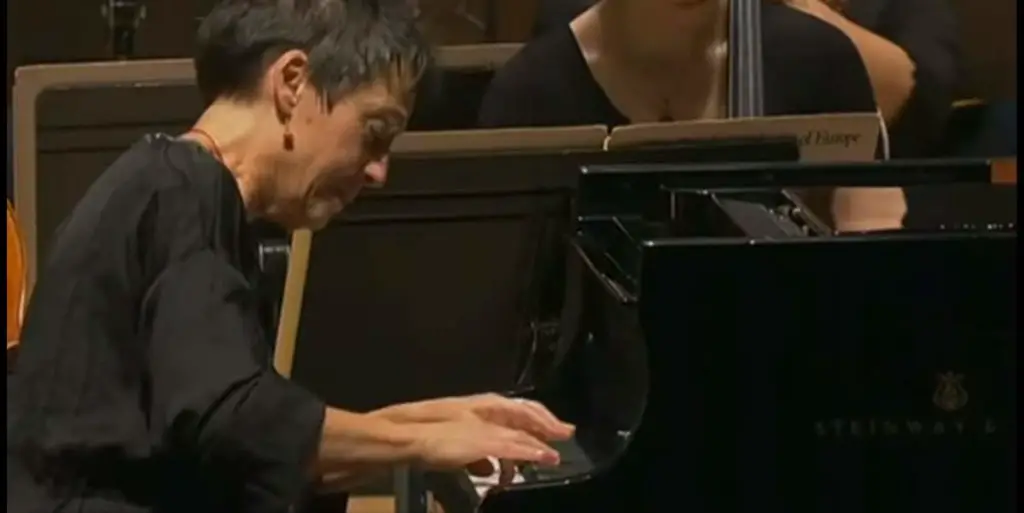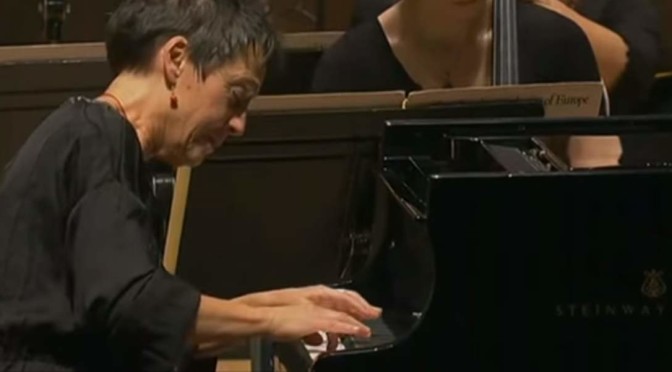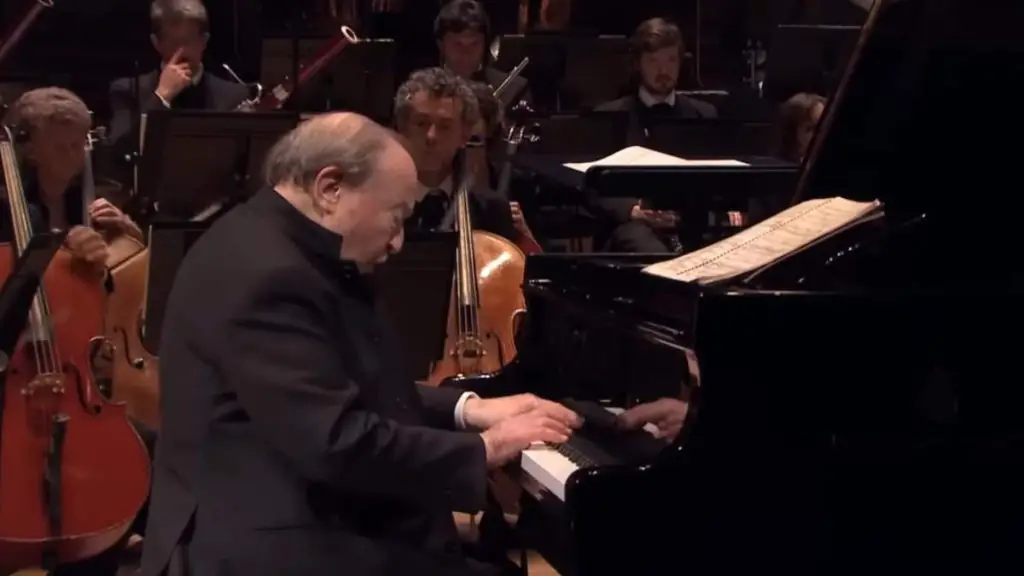Accompanied by the Chamber Orchestra of Europe, the Swiss classical pianist Maria João Pires performs Wolfgang Amadeus Mozart’s Piano Concerto No. 27 in B-flat major, K. 595. First performed early in 1791, the year of his death, it is Mozart’s last piano concerto. Conductor: Trevor Pinnock.
Mozart’s Piano Concerto No. 27
Mozart’s Piano Concerto No. 27 in B-flat major, K. 595, holds a special place in the canon of his works for several reasons. Composed in 1791, the same year as his untimely death, this piece stands as his final statement in the genre of the piano concerto. It has been perceived as Mozart’s musical epitaph, and in it, we hear the full maturity of a composer who had already revolutionized the genre. Though written at a time when Mozart was dealing with financial hardship and deteriorating health, the concerto emanates a sense of grace, optimism, and even serenity that seems to defy the circumstances in which it was created.
Unlike his earlier concertos, which often sparkled with youthful exuberance and dramatic flair, this concerto is marked by its introspective quality and a mature elegance. Its emotional landscape is diverse yet cohesive, encapsulating the full spectrum of human feeling-from joy to sorrow, from contemplation to exuberance-often within a single movement. The concerto isn’t a simple swan song; it’s more like a musical diary capturing the nuanced complexities of life itself.
In terms of structure, the concerto follows the classical three-movement design: an “Allegro,” a “Larghetto,” and another “Allegro” to close. The movements are masterfully crafted to form an emotional journey, starting with the dignified and reflective first movement, moving through the poignant intimacy of the second, and concluding with the optimistic, spirited finale. The individual movements serve as unique emotional vignettes, yet they are so skillfully integrated that the concerto feels like a unified narrative.
One of the noteworthy aspects of this concerto is the collaboration between the piano and the orchestra. Rather than setting up a competitive dynamic between the soloist and the ensemble, Mozart crafts a dialogue between equals. The solo piano doesn’t dominate; it converses, negotiates, and collaborates with the orchestra. This is a reflection of Mozart’s evolving artistic maturity, signaling a move away from the virtuosic showcase towards a more nuanced, democratic form of musical expression.
Harmonically, the concerto is both rich and accessible, employing key modulations and thematic developments that are complex but never feel forced or overly academic. The harmonic language serves the emotional content of the music, adding layers of meaning and depth without ever overshadowing the thematic material.
In the final assessment, Mozart’s Piano Concerto No. 27 is more than just a composition; it’s an emotional and intellectual experience that continues to engage listeners and performers alike, more than two centuries after its creation. It’s a testament to Mozart’s enduring genius that this work can simultaneously encapsulate the wisdom of a life lived fully and the eternal beauty of the musical art form. It feels as if, in this final piano concerto, Mozart was imparting a distilled essence of his musical philosophy – a philosophy that celebrates the complexities of human emotion, the beauty of melody, and the intricate balance of musical form.
Movements
There are three movements, with starting times in the video:
- Allegro (00:11)
- Larghetto in E-flat major (14:23)
- Allegro (21:07)
32:25 – Encores
Mozart Sonata for Four Hands in D Major (Third Movement) K. 381
1. Allegro
Wolfgang Amadeus Mozart’s Piano Concerto No. 27 in B-flat major, K. 595, was his last piano concerto, and its first movement, marked “Allegro,” serves as a sublime introduction to the work. Composed in 1791, the same year as his death, this piece is tinged with an air of nostalgia and introspection, although it also retains a sense of grace and elegance that is quintessentially Mozartian. It’s as if Mozart, at the end of his life, was looking back and reflecting, not just on his career but perhaps on the broader human experience.
The first movement starts off with an orchestral exposition that introduces the main thematic material. The melody is graceful and lyrical, yet simple, creating a sense of clarity and openness. The piano then enters, reiterating the themes while also adding its unique color and character to them. Throughout this movement, one can notice how Mozart’s mature style shines through in the orchestration and the intricate dialogue between the piano and orchestra.
Mozart’s trademark gift for melody is evident throughout, as the movement unfolds with a variety of thematic developments and modulations, yet always maintaining an organic unity. The musical lines are clear and concise, which is a hallmark of his later works. The interaction between the soloist and the orchestra is a refined conversation rather than a confrontation, embodying a kind of musical democracy that was innovative for its time.
The cadenza, a section where the soloist gets to showcase their virtuosity, is often introspective rather than flamboyant in this concerto. Mozart did not write a cadenza for this particular concerto, leaving room for performers to add their interpretation, although some opt for cadenzas that Mozart wrote for other concertos or those penned by later composers. Regardless of the chosen cadenza, it generally serves to deepen the emotional impact of the movement.
This work, and particularly its first movement, showcases Mozart’s ability to convey complex emotional states with great subtlety. It represents a culmination of his life’s work in the genre of the piano concerto, synthesizing his compositional innovations, his understanding of the piano as an expressive instrument, and his ability to write incredibly beautiful melodies. The first movement of Piano Concerto No. 27 serves as both a beautiful piece of music in its own right and as a poignant glimpse into the emotional world of Mozart as he approached the end of his life.
2. Larghetto
The second movement of Mozart’s Piano Concerto No. 27 in B-flat major, K. 595, marked “Larghetto,” is an epitome of understated eloquence and emotional depth. Written in the contrasting key of E-flat major, this movement stands as a serene, yet profoundly moving, centerpiece in the three-movement structure of the concerto. Its musical language is simple, almost transparent, but within that simplicity lies an ocean of emotional nuance.
As the piano introduces the main theme, the listener is immediately drawn into a world of introspection. The theme is tender and somewhat melancholic, imbued with a warmth that seems to hark back to simpler times. This could be interpreted as Mozart reminiscing-whether intentionally or not-about different phases of his life, or perhaps reflecting on life’s ephemeral nature. The melody is ornamented but not overly so, maintaining a purity that invites the listener into its intimate emotional space.
In contrast to the flashier or more virtuosic second movements one might find in other concertos, the Larghetto of this concerto focuses on depth rather than dazzle. Mozart opts for a more straightforward texture, where the solo piano and orchestra support rather than challenge each other. The piano develops the theme in subtle variations, interacting with the orchestra in a delicate exchange of musical ideas. The orchestration remains restrained, adding layers of emotional resonance but never overpowering the central narrative carried by the piano.
As the movement progresses, Mozart employs elegant modulations and harmonic shifts to deepen the emotional complexity. Despite its relative brevity, the movement traverses a wide emotional spectrum, from yearning to consolation, always maintaining an overarching sense of poise and dignity. This is a testament to Mozart’s genius; he could express a world of feeling within the span of a few minutes and with the simplest of musical materials.
The “Larghetto” gradually unfolds back to its main theme, creating a sense of closure and wholeness, yet leaving behind a trail of unanswered questions and lingering emotions. When it concludes, the listener is often left in a contemplative state, as if having journeyed through a poignant emotional landscape that defies easy description.
The second movement of Mozart’s Piano Concerto No. 27 serves not just as a moment of reprieve between the more upbeat first and third movements but also as an intimate emotional core of the work. It embodies the maturity of Mozart’s late style, characterized by emotional depth, clarity of structure, and an impeccable balance between the solo instrument and orchestra. The music stands as a sublime example of how Mozart could capture the complexities of the human experience with an almost divine sense of grace.
3. Allegro
The finale of Mozart’s Piano Concerto No. 27 in B-flat major, K. 595, is an “Allegro,” and it brings the concerto to a close with a sense of joyful resolution. After the introspective, almost contemplative nature of the second movement, the third movement acts as a return to life’s more cheerful and optimistic aspects. It is imbued with an effervescent quality that lifts the spirit, yet it also retains the mature, reflective sensibility found throughout the concerto. The movement seems to capture a multifaceted emotional spectrum as if Mozart is saying farewell but also leaving us with a sense of hope and affirmation.
Musically, the movement is in a rondo form, which is characterized by the recurrence of a principal theme that alternates with different episodes. The main theme introduced at the beginning is playful and spirited, with rhythmic motifs and melodic turns that capture the listener’s attention. This is classic Mozart: even within a lighter, jovial context, he introduces complexities that add depth to the musical experience.
The piano and the orchestra engage in a lively dialogue, each taking turns developing thematic material. The textures are transparent but rich, revealing Mozart’s knack for balancing complexity and simplicity. This alternating pattern between the main theme and contrasting episodes creates a sense of forward motion and increasing excitement. However, unlike some of his earlier works where the final movement might be an outright fireworks display of technical prowess, this one has a subtler charm. It is virtuosic but not ostentatious, sophisticated yet unpretentious.
Harmonically, Mozart navigates interesting territories as well. He employs unexpected modulations that add a layer of surprise and delight, and these harmonic twists enrich the narrative while keeping the listener engaged. It’s like a lively conversation among old friends-full of wit, occasional teasing, and lots of understanding.
As the movement nears its conclusion, the music gathers momentum for a final, exuberant statement of the main theme, ending the concerto on a note of unequivocal optimism. The journey from the elegance of the first movement through the intimate depth of the second to the spirited finale of the third provides a comprehensive emotional experience for the listener. The third movement acts as a perfect counterbalance to the preceding ones, creating a holistic work of art that covers a wide emotional and thematic range.
Like the other movements of this concerto, the third movement reflects Mozart’s unparalleled ability to convey a complex emotional world within the constraints of classical form and balance. It is a fitting end to his final piano concerto, serving as both a conclusion and a kind of musical legacy, encapsulating themes and techniques he had developed throughout his life.
Maria João Pires

Maria João Pires (born in Lisbon, Portugal, 23 July 1944) is a Swiss pianist. Her first recital was at the age of five, and at the age of seven, she was already playing Mozart piano concertos publicly. Two years later she received Portugal’s top prize for young musicians. In the following years, she studied with Campos Coelho at the Lisbon Conservatory, taking courses in composition, theory, and history of music. She continued her studies in Germany, first in the Musikakademie of Munich with Rosl Schmidt and then in Hanover with Karl Engel.
International fame came in 1970 when she won the Beethoven Bicentennial Competition in Brussels. Subsequently, she performed with major orchestras in Europe, America, Canada, Israel, and Japan, interpreting works by Bach, Beethoven, Schumann, Schubert, Mozart, Brahms, Chopin, and other classical and romantic composers.
Her professionalism achieved worldwide recognition when a film (from 1999) was drawn to the attention of the press and went viral in 2013. At the start of a lunchtime concert in Amsterdam, she realized that she had rehearsed for a different Mozart concerto from the one the orchestra had started playing (Piano Concerto No.20 in D minor, K.466); quickly recovering, she played the concerto from memory (see the video below).
How come a pianist thinks that s/he is going to play another concerto? What are rehearsals for? The answer is that this recording was part of a Lunch Concert. These are free concerts in Amsterdam. Sometimes they feature new talents, and sometimes rehearsals of the Royal Concertgebouw Orchestra, like in this case. So, it IS the rehearsal, but at the same time, it IS a real concert.
At the highest levels of professional musicians, guest soloists are not always expected to rehearse with the accompanying orchestra ahead of time, especially for a “casual” concert setting. For formal concerts, this would never occur, due to multiple mandatory rehearsals ahead of time (not to mention the dress rehearsal).
Pires performed at the BBC Proms in 2010. In an interview beforehand, she said that after 60 years of recitals and concerts, she had cut back her performances but was non-committal about retirement.
Since September 2012, she has been a “Master in residence” at the Queen Elisabeth Music Chapel (Waterloo, Belgium), where she teaches piano to young talented pianists from all over the world.
Sources
- Pavarotti sings Pourquoi me réveiller [Massenet] at the Central Park in 1993 - April 23, 2024
- Elgar: Serenade for Strings [Concertgebouw Chamber Orchestra] - April 19, 2024
- Mozart: Serenade No. 10 “Gran Partita” [MET Orchestra Chamber Ensemble] - April 18, 2024


